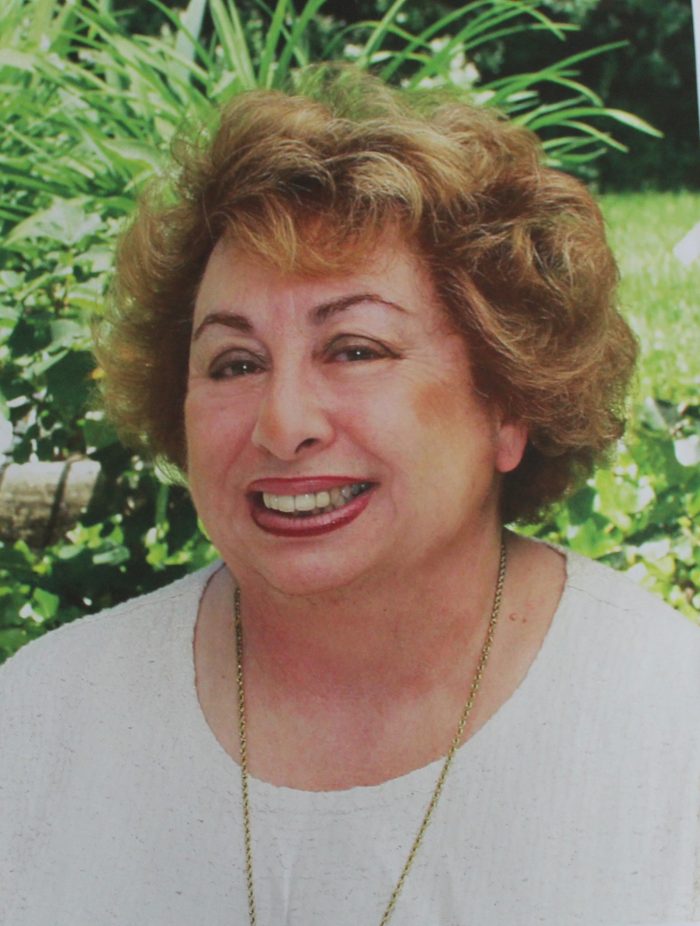Everything Judi Betts ever did, she did with persistence. Whether selling raffle tickets, hosting guests or persevering through the sharp bouts of orthopedic pain later in life, she did so with a tenacious, indefatigable spirit.
Those who knew her say a love of family, friends, community and country guided her. Like a high-speed locomotive, her wheels were always churning and churning away. Betts channeled her abundant energies and limitless altruism into the charitable causes that defined her life.
Now those wheels churn no longer. Betts died in her sleep Wednesday, Jan. 4, at the Sunrise of Holbrook assisted living center. In her passing, she leaves an enduring legacy of community service and an indelible mark upon the lives she touched.
A dynamic team
Judith “Judi” Betts was born on Sept. 8, 1941, to Dominick and Jessie Annibale. She, her brother Kenneth and her parents soon moved to Bellerose, Queens, in the early ‘50s. Her father’s untimely death in 1955 was a profound loss to the Annibale family, prompting Jessie to raise the two kids on her own.
In 1959, Judi graduated from St. Mary’s High School in Manhasset, where she remained an active alumna and patron of the parish. She married in 1961, and then remarried in 1982 to Earle Betts, a World War II Navy veteran and board member at Mather Hospital in Port Jefferson.
Judi’s cousin, Ronnie Ridolfi, described Earle as a “perfect gentleman.” The Betts couple settled in a historic home on High Street, the nexus for various social gatherings and benefit events. Together, they were a dynamic team, joint advocates for numerous charitable causes and local organizations. Following Earle’s death in 2002, Judi carried her husband’s torch, Ridolfi added.
With unparalleled compassion and enthusiasm, Betts thrust herself into the world of Port Jefferson with the goal of continual community advancement. “She liked representing her area,” said Mary Ann Ridolfi, Betts’ cousin by marriage. “And she liked helping people.”
Master fundraiser
Betts was renowned for her untiring support of the many charitable causes and organizations to which she was committed throughout her life. The four organizations encompassing her values and community aspirations were St. Mary’s High School, Mather Hospital, Port Jefferson Rotary Club and the Boy Scouts of America.
Michael Sceiford, a friend and fellow Rotarian, characterized Betts’ community involvement. “She immersed her life in these charitable causes,” he said. “Her personality was to never sit idle, to be out there trying to help the community through these different organizations that she was extremely passionate about.”
She also served on the Suffolk County Council of the Boy Scouts of America. Brian McAuliff, a past council president and longtime Scoutmaster, touched upon the intensity and conviction with which Betts pursued her fundraising obligations.
“If we had a meeting to do a fundraiser, everyone would take some notes, and a few days later, they would get to their tasks that they committed to,” he said. “Judi was on that task the very next minute. Being persistent about the cause, she was able to do some really great things.”
Jolie Powell, a friend and neighbor, said Betts excelled in fundraising. “She could sell tickets better than anyone I’ve met,” Powell said. “She loved the challenge, and she loved to hear that she was the one that sold more tickets than anyone.”
Interpreting this competitive impulse, Ronnie Ridolfi saw in Betts an earnest desire to effect positive change in the lives of others. “That was a drive that was in her, always to be more than the best,” he said. “By doing that with the fundraisers and the charitable contributions,” she had found her life’s task.
Persistence
A doctor once told Betts that the word “persistence” represented her outlook on life. “She didn’t give up,” Mary Ann Ridolfi said. “She would always tell you to be involved, don’t sit around, get involved and know what’s going on around you.”
Ronnie Ridolfi suggested this quality, along with her community-centric approach and relentless determination for service, were all innate qualities. “As a young lady, that was her calling,” he said.
Powell viewed this quality as an inherent feature of Betts’ personality. “She was like a warrior,” she said. “That’s what made her who she was and as far as doing what she loved to do best, which was volunteering.”
Sceiford said Betts’ philanthropic enterprise was undiminished despite declining health later in life. Fighting through chronic pain, she continued to support these causes until the very end. In the face of health problems, “she continued to persevere and push on,” he said.
Several people recounted one notable fundraising event organized at Betts’ historic home that raised $50,000 in 2021. The benefit brought together Mather Hospital and the Boy Scouts of America, Northwell Health president and CEO Michael Dowling, and various local officials.
McAuliff referred to the immense logistic challenges in bringing that event to fruition, especially given Betts’ health. “She was in a wheelchair, sometimes in and out of the hospital, and she still was able to pull off that amazing event,” he said. “It’s just a testament to her tenacity and persistence.”
Legacy
Betts brought in several foreign exchange students, highlighting another aspect of her character. Two such students, Elizabeth of Venezuela and Wenzel of Germany, remained in close contact with her and visited until the end of her life.
Friends and family remember Betts as an eccentric, charismatic, vibrant individual, a connoisseur of wine and an active promoter of the East End-based Pindar and Duck Walk vineyards.
She was also a proud American patriot. The Ridolfis maintained that she passionately supported her brother Kenneth, a Vietnam War veteran. “She helped Kenny a great deal with the VA,” Ronnie said. “He became sick, and she got involved with the VA to help him with his benefits.”
McAuliff said Betts’ patriotic fervor expressed itself through her volunteer activities. “She was a very proud American, very proud of the country, and saw the Boy Scouts of America as something that represented what was best about America,” he said.
For Sceiford, Betts’ inviting personality drew others into her web. Through this, she developed lasting relationships throughout her life. “She took her friends in as her family,” he said.
Through her example, he added that community members “can learn that they can truly make a difference in the community. … She did the work of what 25 other people maybe did. She made a huge impact to the community.”
McAuliff voiced a similar opinion. Reflecting upon Betts’ model of service, he added that her love for people and her selflessness would leave an abiding impression on those who remember her.
“Everybody who knew her became a part of her family,” he said. “I think that she adopted the community and the community organizations as her children,” adding, “It’s a life of giving, a life of persistent giving.”
Betts was laid to rest Tuesday, Jan. 10, alongside Earle at Calverton National Cemetery, her procession escorted by Suffolk County Highway Patrol, the bagpipers performing a moving tribute to a life well lived.
The four organizations to which Betts devoted her life were each represented at her visitation and funeral services. She will be greatly missed by family and friends.






